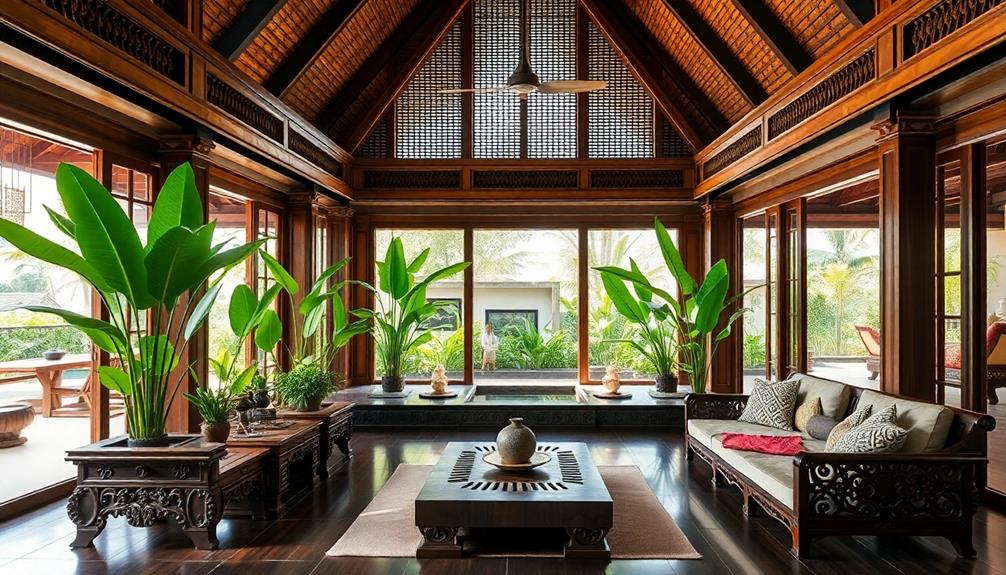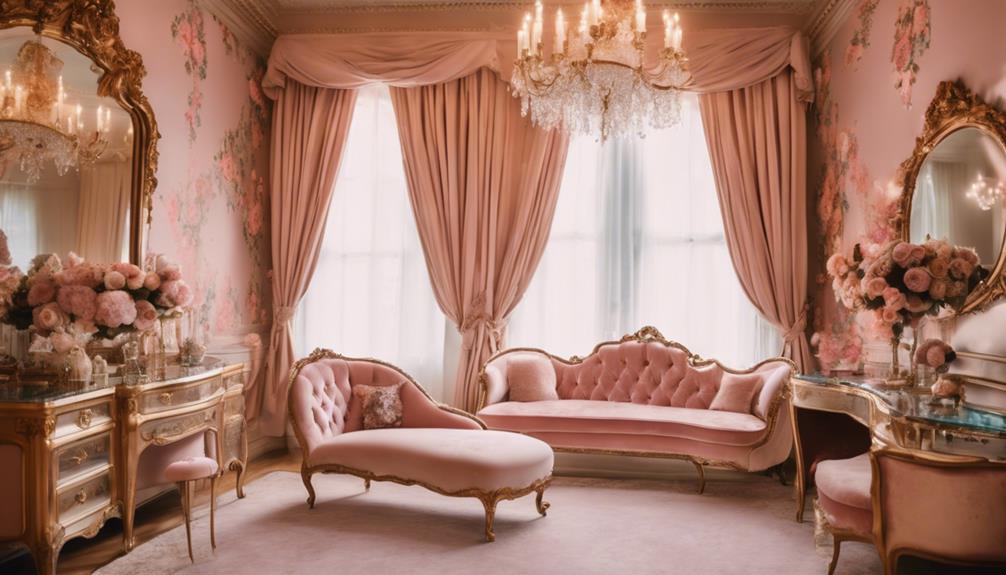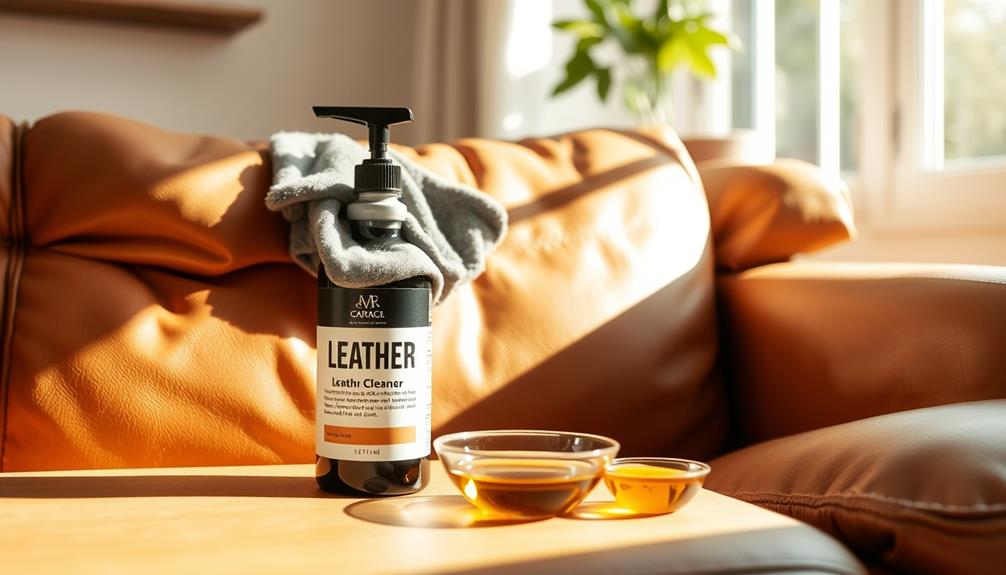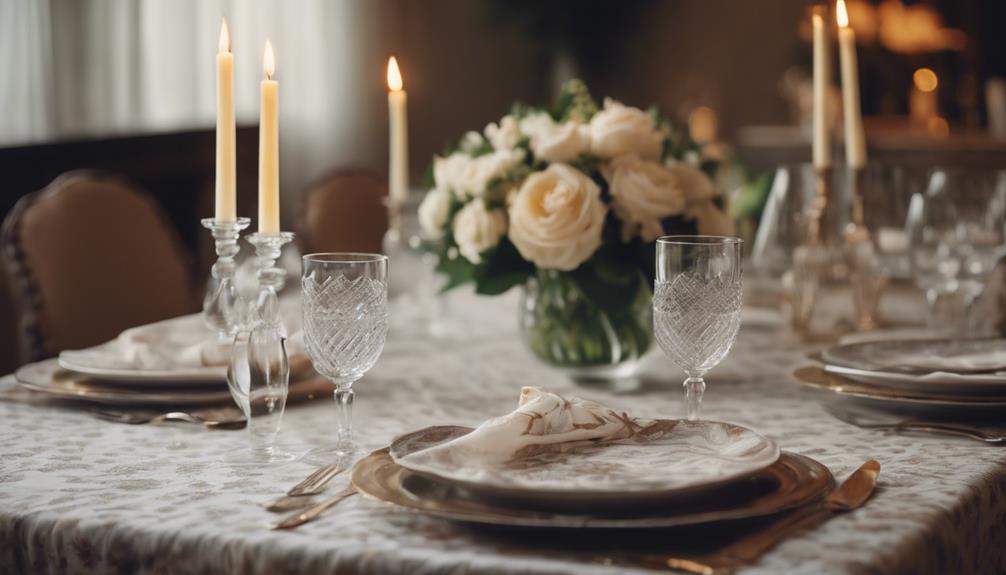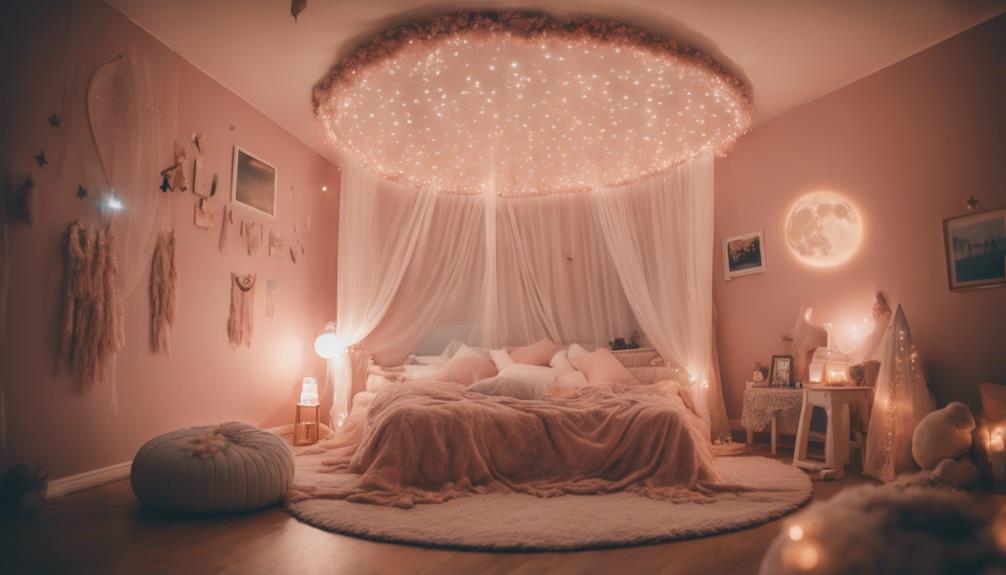Balinese interior design is popular because it seamlessly blends natural elements with cultural authenticity. You'll love its use of sustainable materials like wood and bamboo, which create a warm and inviting atmosphere. The open spaces maximize natural light and foster a connection to the outdoors. Earthy color palettes combined with vibrant textiles add visual interest while promoting relaxation. Traditional craftsmanship shows off local artistry, making each piece unique. This style not only embraces eco-friendly practices but also enhances tranquility in any home. Stick around to uncover more fascinating elements that make Balinese design truly exceptional.
Key Takeaways
- Balinese interior design combines traditional and modern elements, emphasizing natural materials like wood, stone, and bamboo for warmth and sustainability.
- Open spaces with large windows and sliding doors promote seamless indoor-outdoor integration, maximizing natural light and enhancing livability.
- Cultural textiles such as batik and ikat add depth and authenticity, enriching the decor with vibrant colors and patterns.
- Earthy tones dominate the color palette, creating a serene atmosphere, while vibrant accents provide visual interest.
- Sustainable practices, including locally sourced materials and energy-efficient systems, support eco-friendly living and reduce environmental impact.
Overview of Balinese Interior Design
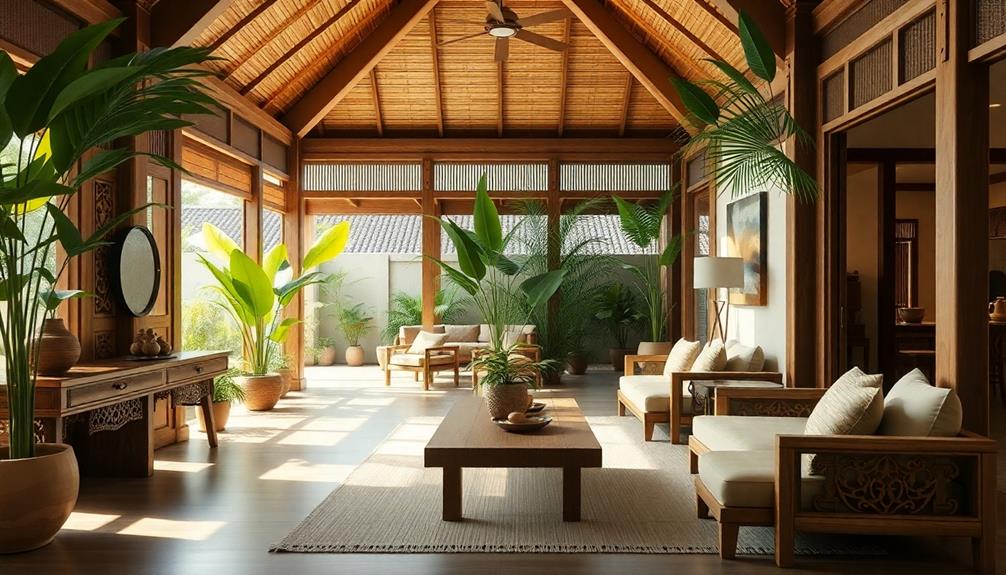
In the domain of interior design, Balinese aesthetics stand out for their unique blend of traditional and modern elements. Emerging in the early 1990s, this style reflects Indonesian architect Made Wijaya's vision to harmonize Balinese architecture with contemporary designs.
You'll notice that Balinese interiors emphasize natural materials like wood, stone, bamboo, and rattan, creating warm and inviting spaces that promote sustainability. This design approach also incorporates natural ventilation techniques that enhance comfort and enhance the overall living experience.
One of the most striking features you'll find are the open-air designs. Large windows and sliding doors facilitate a seamless connection between indoor and outdoor environments, allowing for a tranquil atmosphere that embodies relaxation.
Traditional textiles such as batik and ikat further enhance the cultural authenticity of these spaces, while artistic wood carvings and sculptures add a unique touch.
Color plays a crucial role too; a cohesive palette of earthy tones and vibrant accents contributes to the inviting ambiance.
Key Features and Elements
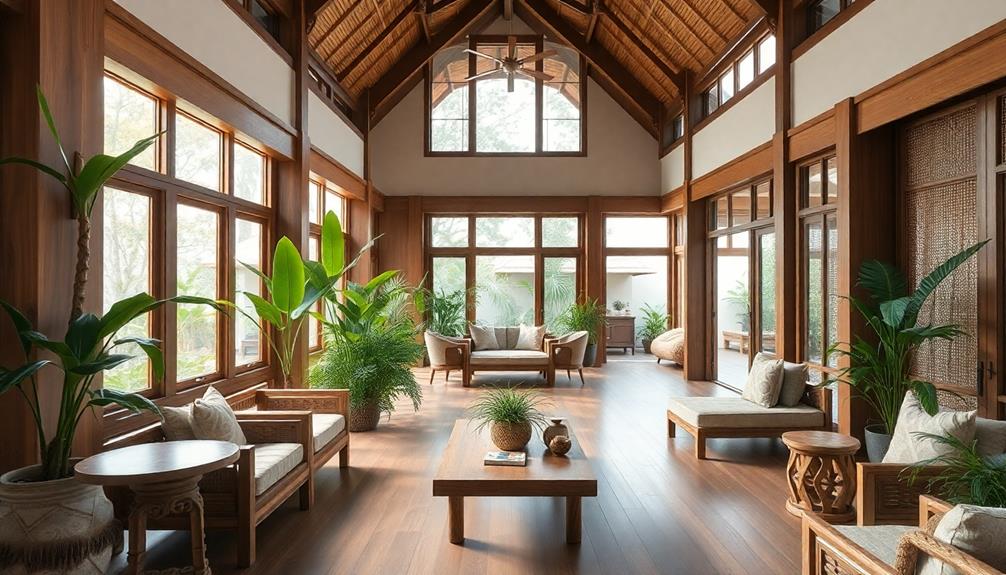
Balinese interior design embodies a harmonious blend of natural elements and cultural richness. You'll find that this style prominently features natural materials like wood, bamboo, stone, and rattan, creating a warm and inviting atmosphere while emphasizing sustainability. Open-air designs are another hallmark, allowing for seamless integration between indoor and outdoor spaces through large windows and sliding doors that maximize natural light.
Here's a quick overview of key features:
| Feature | Description |
|---|---|
| Natural Materials | Wood, bamboo, stone, and rattan for warmth |
| Open-Air Designs | Large windows and doors for indoor-outdoor flow |
| Traditional Textiles | Batik and ikat used in upholstery and decor |
| Earthy Tones | Browns and greens with vibrant accents |
Additionally, the incorporation of water features, such as ponds and fountains, along with tropical plants, enhances tranquility and reinforces the design's connection to nature. Balinese furniture complements these elements, creating a serene and cohesive living environment. By embracing these features, you can bring the essence of Bali into your home.
Color Schemes and Atmosphere
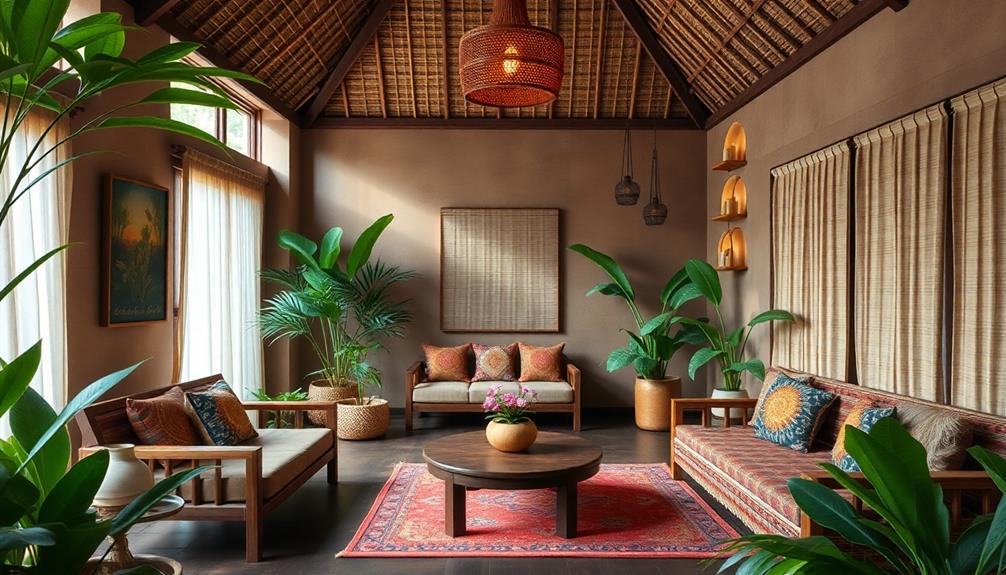
The color schemes in Balinese interior design create a serene and grounded atmosphere that complements the natural elements of the space. You'll find a chiefly neutral palette featuring earthy tones like whites, browns, and greens, which promotes tranquility.
To add visual interest, vibrant colors such as deep reds and golds are used sparingly as accents, reflecting Bali's rich tropical environment. This approach is often seen in luxury tropical design aesthetics, where the integration of natural materials and colors fosters an inviting ambiance.
This thoughtful color selection is guided by holistic design principles aimed at achieving balance and harmony. By carefully managing the use of bold colors, the design avoids overwhelming decor while enhancing the overall aesthetic.
Traditional paintings and intricate carvings often serve as focal points, offering cultural depth and authenticity that enriches your surroundings.
Incorporating tropical greenery and colorful flowers further enhances the atmosphere, connecting your indoor space with the lush beauty of nature.
As you embrace these color schemes, you'll create an inviting environment that feels both serene and vibrant, making your home a true reflection of Balinese elegance.
With each element harmonizing beautifully, you'll enjoy a space that's not just visually appealing but also deeply connected to its cultural roots.
Creating Open Spaces
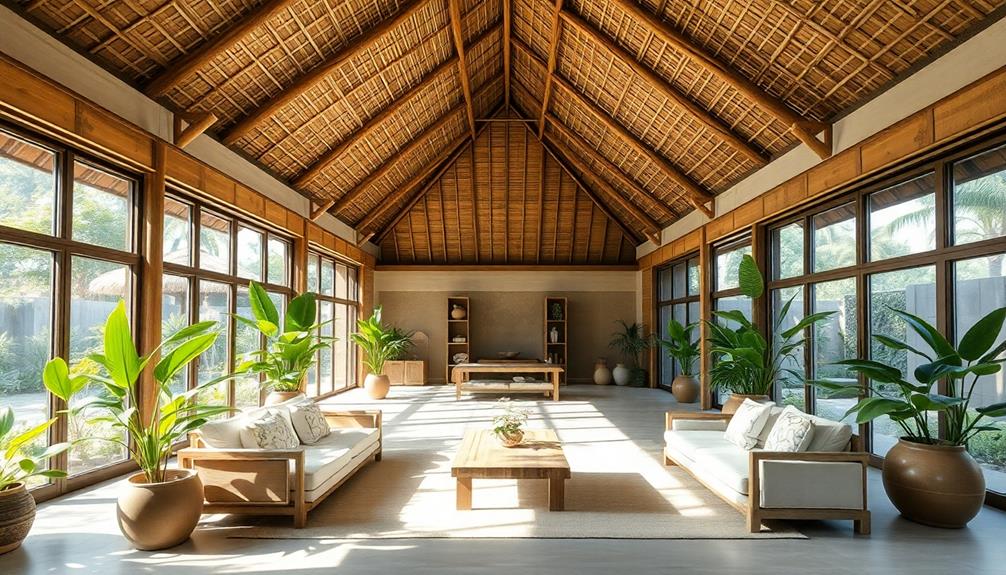
In Balinese interior design, creating open spaces is all about achieving a seamless flow between indoors and outdoors.
You'll notice generous use of natural light through large windows and sliding doors, making your home feel bright and airy.
This connection not only enhances your living experience but also invites nature right into your daily life.
Seamless Indoor-Outdoor Flow
Creating a seamless indoor-outdoor flow is essential for achieving a harmonious living space that feels connected to nature.
This design principle not only enhances the aesthetic appeal but also improves your overall well-being. Incorporating elements of traditional Indonesian style home decor can further enrich this connection with nature.
Here are three key aspects to reflect upon:
- Open Floor Plans: These layouts encourage a seamless flow between indoor and outdoor spaces, making your home feel more expansive and inviting.
- Natural Materials: Incorporating materials like wood and stone reinforces the connection between the inside and the outside, creating a cohesive look that celebrates nature.
- Plants and Greenery: Integrating tropical plants and water features brings the tranquility of Balinese gardens into your home, enhancing relaxation and comfort.
You can maximize natural light with large windows and sliding doors, creating unobstructed views that invite the beauty of your surroundings inside.
Thoughtfully designed outdoor living areas with comfortable seating encourage you to enjoy your natural surroundings year-round.
By focusing on these elements, you'll create a space that embodies tranquility and promotes a lifestyle deeply connected to the environment.
Embrace the Balinese style, and watch your living space transform into a true sanctuary.
Generous Natural Light Usage
Emphasizing generous natural light usage complements the seamless indoor-outdoor flow characteristic of Balinese design. By incorporating open floor plans, you can foster natural airflow and unobstructed views, creating a sense of spaciousness that invites the outside in.
Large windows and sliding doors play a significant role in maximizing natural light, ensuring your home feels bright and airy throughout the day. This design approach not only enhances livability but also nurtures a serene ambiance, making your space feel peaceful and inviting.
The integration of indoor and outdoor areas allows for smooth shifts, promoting a harmonious environment where nature becomes an integral part of your home. Moreover, incorporating elements like Indonesian decorative pillows can enhance the aesthetic while maintaining comfort.
Skylights are another effective element to reflect upon; they enhance natural light exposure and elevate your home's atmosphere, contributing to an uplifting experience. Additionally, generous natural light usage supports energy efficiency, reducing the need for artificial lighting during daylight hours.
Incorporating Nature-Inspired Elements
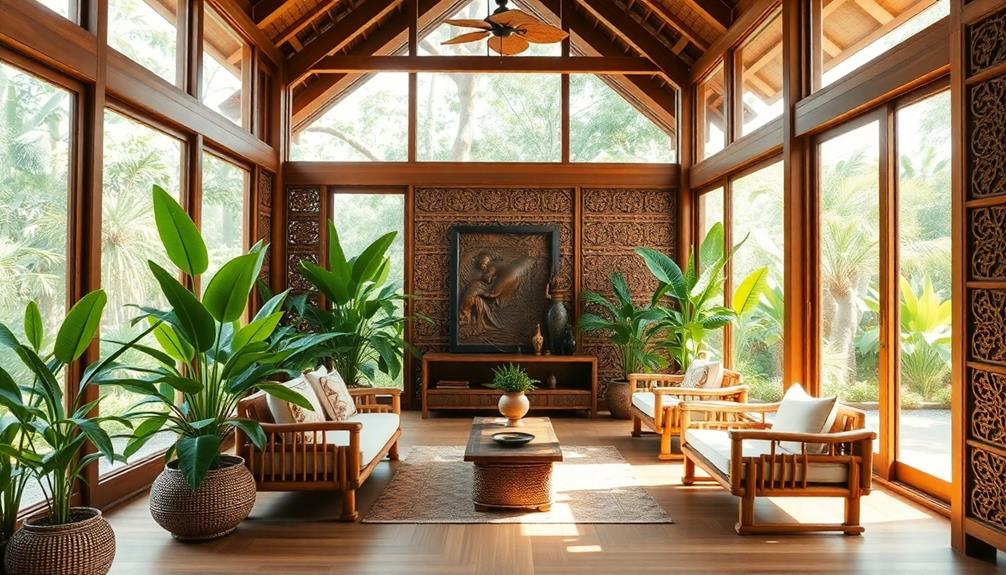
Balinese interior design beautifully blends indoor and outdoor spaces, making nature a central element of the home. This integration creates an atmosphere of tranquility, allowing you to feel connected to the lush surroundings.
The emphasis on using natural materials like wood and stone further enhances this connection to the environment. Here are three key ways to incorporate nature-inspired elements into your space:
- Tropical Plants: Use a variety of indoor tropical plants, such as palms and ferns, to enhance air quality and bring the vibrant essence of greenery indoors.
- Water Features: Include soothing water elements like ponds or fountains that not only promote serenity but also provide calming sounds throughout your living area.
- Natural Materials: Opt for flooring crafted from volcanic rock or river stone, offering a grounded feel that complements your nature-inspired theme.
Modern Balinese Interior Style
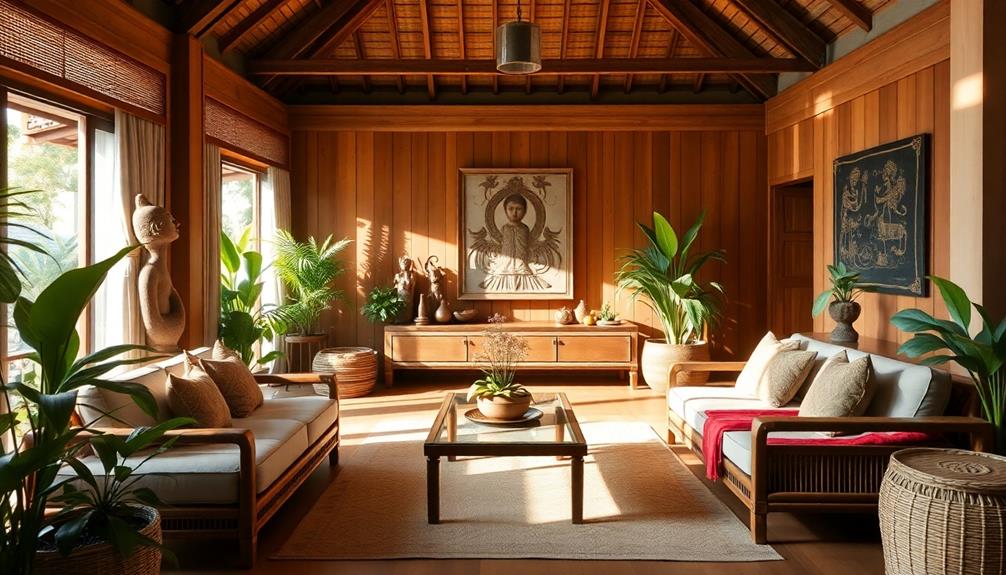
Harmony defines the modern Balinese interior style, where seamless shifts between indoor and outdoor spaces create a tranquil living environment. You'll love how this design emphasizes an indoor-outdoor flow, using large windows and open floor plans to invite natural light and airflow.
By incorporating sustainable natural materials like bamboo, teak, and stone, the space promotes an organic aesthetic that connects you with nature. Additionally, traditional artistry can be reflected in decor choices, such as vibrant Indonesian masks that enhance the space's aesthetic appeal.
In this style, earthy tones dominate the color palette, creating a soothing backdrop. You can introduce vibrant accents through textiles and accessories, enhancing the calming yet visually appealing atmosphere.
Low-profile furniture and handcrafted pieces showcase organic shapes and textures, adding to the overall tropical feel and encouraging relaxation.
To further enhance tranquility, consider adding water features such as ponds or fountains. These elements provide serenity and embody the essence of Balinese living.
In modern Balinese style, each choice in furniture and decor reflects a commitment to creating a peaceful, harmonious space. Embracing this approach not only transforms your home but also fosters a deep connection with the natural world surrounding you.
Key Materials and Furniture
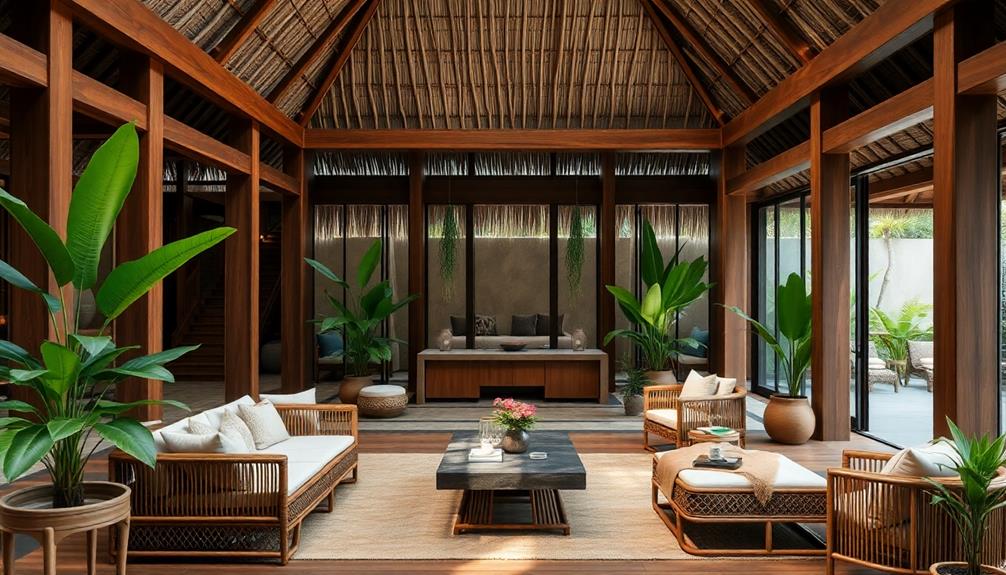
When creating a Balinese interior, you'll want to focus on natural materials that reflect the beauty of the island. When creating a Balinese interior, you’ll want to focus on natural materials that reflect the beauty of the island. Incorporate elements such as bamboo, teak wood, and rattan for a truly authentic feel, paired with soft, earthy tones. To enhance the space, consider selecting decor or furniture pieces made of metal with intricate designs. For these, exploring lightweight metal selection tips can be a great way to ensure you choose designs that are both practical and align with the serene, airy aesthetic of Balinese style.
Handcrafted furniture made from solid woods showcases the artistry and unique character of Balinese craftsmanship, emphasizing sustainable craftsmanship in Balinese furniture.
Don't forget to integrate vibrant textiles and accessories, as they add depth and warmth to your space.
Natural Material Selection
In Balinese interior design, natural materials play an essential role in creating inviting and serene spaces. By choosing the right materials, you can enhance the organic feel of your home.
Incorporating tropical villa plans can further emphasize the connection to nature and create an open, airy environment. Here are three key elements to reflect upon:
- Teak Wood: Known for its durability and beauty, teak wood is often used for furniture pieces. Its intricate carvings reflect Bali's rich cultural heritage, adding character to your space.
- Rattan: This versatile material is perfect for both traditional and modern designs. Lightweight and durable, rattan furniture pieces work well indoors or outdoors, promoting a relaxed atmosphere.
- Natural Fibers: Incorporating materials like jute and sisal not only adds texture but also contributes to a warm and inviting environment.
These natural fibers enhance the overall aesthetic, making your home feel cozy and welcoming.
Handcrafted Furniture Importance
Emphasizing craftsmanship and sustainability, handcrafted furniture plays an essential role in Balinese interior design. By utilizing sustainable natural materials like teak, bamboo, and rattan, this furniture guarantees a strong connection to the island's cultural roots and environment.
The intricate carvings displayed in Balinese pieces not only highlight traditional craftsmanship but also convey deep cultural significance, often featuring religious themes or traditional motifs. Furthermore, incorporating unique elements like Indonesian decor masks can further enhance the cultural richness of your space.
Low-profile seating arrangements are another hallmark of Balinese furniture, promoting a relaxed atmosphere and facilitating seamless indoor-outdoor flow in your living spaces. This design approach encourages a harmonious connection with nature, making your home feel more open and inviting.
Additionally, durable natural fibers and textures, such as jute and sisal, enhance the aesthetic while adding warmth and comfort.
The modern integration of handcrafted furniture allows for a blend of traditional craftsmanship and contemporary design, making it versatile for various interior styles. By choosing Balinese handcrafted furniture, you embrace sustainability and cultural heritage, enriching your home with pieces that tell a story and create an inviting environment.
Textiles and Accessories Integration
Balinese interiors come alive through the thoughtful integration of textiles and accessories, which enrich the space with color, texture, and cultural depth. Incorporating elements such as Indonesian decor masks can further enhance the aesthetic appeal and serve as conversation starters.
If you want to embrace this style, consider these key elements:
- Vibrant Textiles: Incorporate batik and ikat fabrics for upholstery, cushions, and throws. These traditional textiles add not only vibrant colors but also a rich cultural significance to your decor.
- Natural Materials: Use furniture made from teak, rattan, and bamboo. These materials showcase organic shapes and intricate carvings, reflecting Bali's traditional artistry and craftsmanship.
- Cultural Accessories: Enhance your space with decorative elements like Balinese masks, sculptures, and woven baskets. These accessories serve as focal points that contribute to the overall cultural ambiance.
The integration of natural fibers in rugs and textiles adds to the earthy feel characteristic of Balinese decor.
Low-profile furniture arrangements promote a relaxed atmosphere, while colorful throw pillows and textiles introduce warmth and visual interest.
Lighting Design and Ambiance
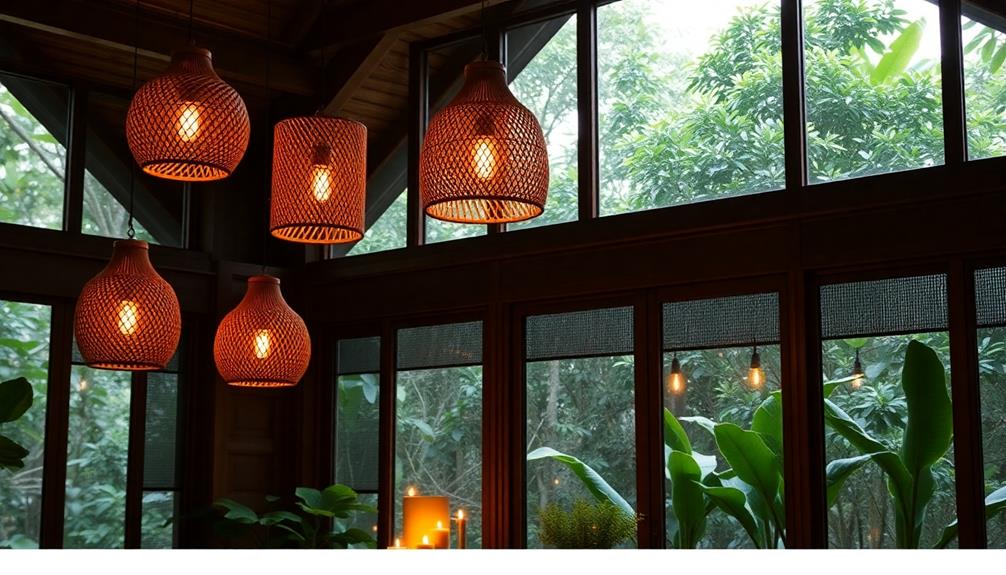
With a focus on natural light, Balinese interior design creates an inviting atmosphere that seamlessly blends indoor and outdoor spaces. Large windows, sliding doors, and skylights are essential elements, allowing sunlight to flood your home and enhance the organic aesthetic.
You'll find that lighting fixtures often incorporate natural materials like bamboo and rattan, which not only look beautiful but also contribute to a warm ambiance. Dimmable lighting solutions are a great addition, enabling you to adjust the mood for relaxation or social gatherings.
To further enhance tranquility, decorative elements such as lanterns and candles bring a soft glow that makes your space feel cozy and welcoming. By integrating these lighting options, you cultivate a serene environment that encourages unwinding at the end of the day.
Moreover, energy-efficient lighting is a smart choice, aligning with sustainable practices and reducing your environmental impact. This commitment to sustainability doesn't sacrifice style; instead, it enhances the overall aesthetic of your Balinese interior.
Embracing these lighting design principles not only elevates your home's beauty but also promotes a harmonious living experience.
Sustainability Practices in Design
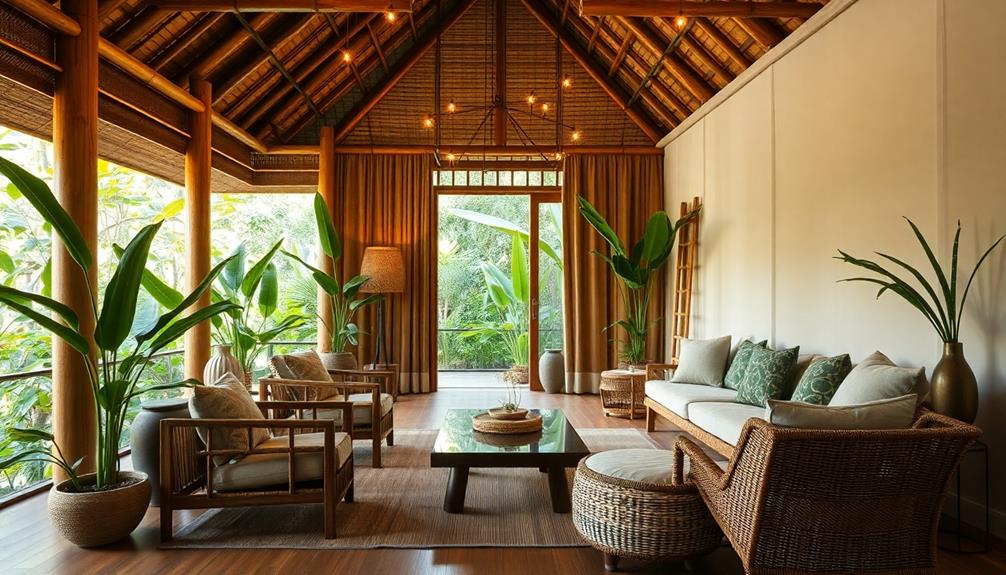
Integrating sustainability practices in design is essential for creating a harmonious living space that respects the environment. Balinese interior design excels in this area, offering an eco-friendly approach that enhances your home while minimizing its ecological impact.
Here are three key sustainable practices to reflect upon:
- Locally Sourced Materials: Using bamboo and rattan not only supports local artisans but also reduces your carbon footprint.
- Energy-Efficient Systems: Incorporating solar panels promotes eco-friendly living and decreases reliance on non-renewable energy sources.
- Water Conservation Techniques: Methods like rainwater harvesting help maintain lush gardens while minimizing water usage.
Additionally, Balinese designs often feature natural ventilation through open floor plans and large windows, which lowers energy consumption by reducing the need for artificial cooling.
The use of reclaimed materials and responsible sourcing of timber further guarantees the preservation of ecological balance.
Frequently Asked Questions
What Is the Interior Design Style in Bali?
In Bali, you'll find an interior design style that emphasizes natural materials like wood and stone, open spaces, and earthy tones. This approach creates a warm, inviting atmosphere that beautifully connects indoor and outdoor environments.
What Are the Characteristics of Balinese Houses?
Balinese houses feature open-air designs that blend indoor and outdoor spaces, utilize natural materials like wood and stone, showcase intricate carvings, and often include serene water features, creating a tranquil, inviting atmosphere you'll love.
What Is the Style of Balinese Architecture?
Imagine living in a paradise where nature embraces your home. Balinese architecture boasts breathtaking thatched roofs, open-air designs, and stunning wood carvings, creating an enchanting blend of beauty, sustainability, and harmony with the environment.
What Are the Principles of Balinese Design?
Balinese design principles emphasize natural materials, open spaces, and a neutral color palette. You'll appreciate how water features create tranquility, while traditional motifs celebrate cultural heritage, making your environment feel serene and connected to nature.
Conclusion
In embracing Balinese interior design, you're not just decorating; you're transforming your space into a tropical paradise that practically whispers serenity. With its harmonious blend of nature and modernity, you'll feel like you're living in a luxurious resort every single day! The rich colors, open layouts, and natural elements will have your friends swooning with envy. So go ahead, immerse yourself in this enchanting style and let your home radiate the breathtaking beauty of Bali itself!
